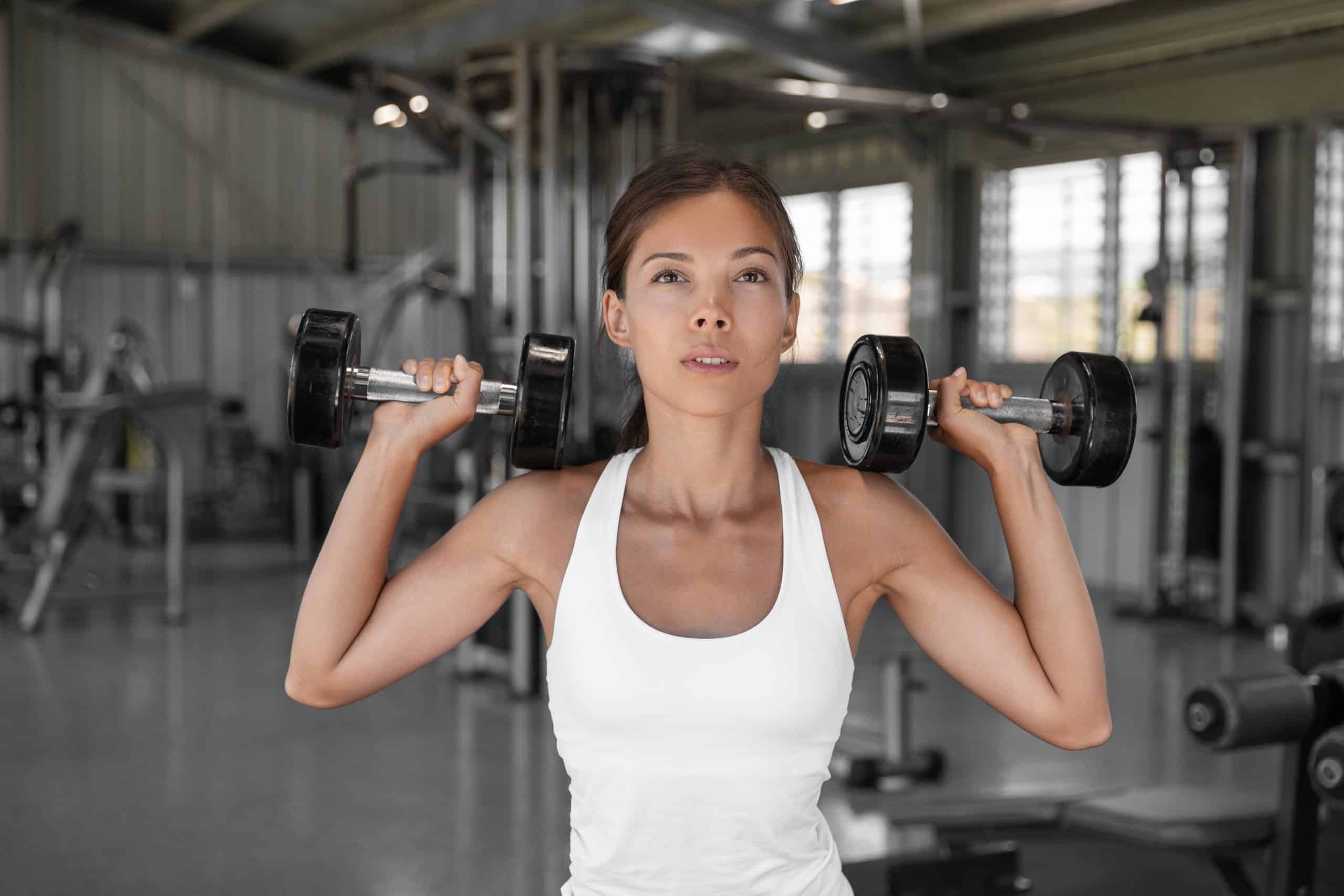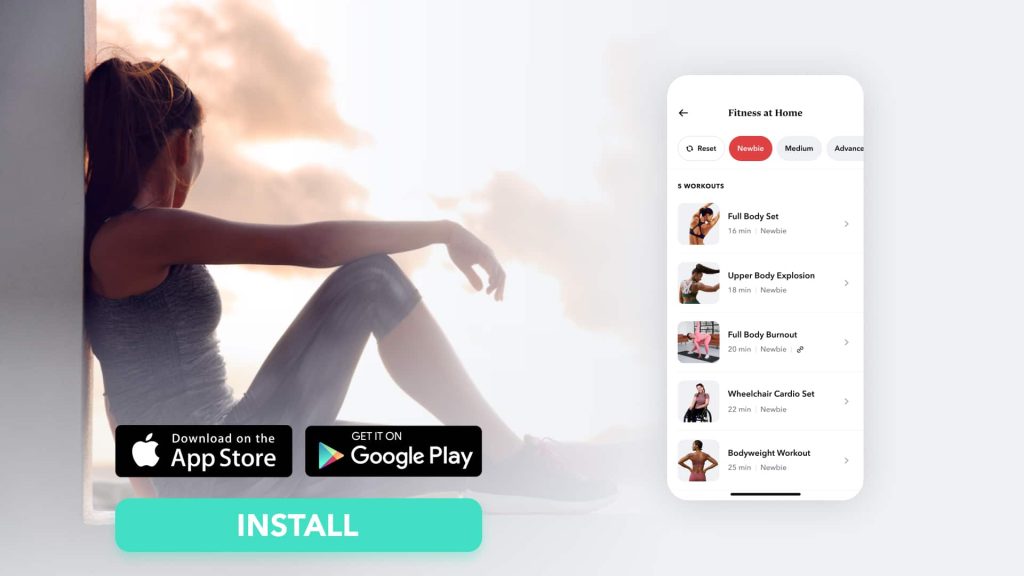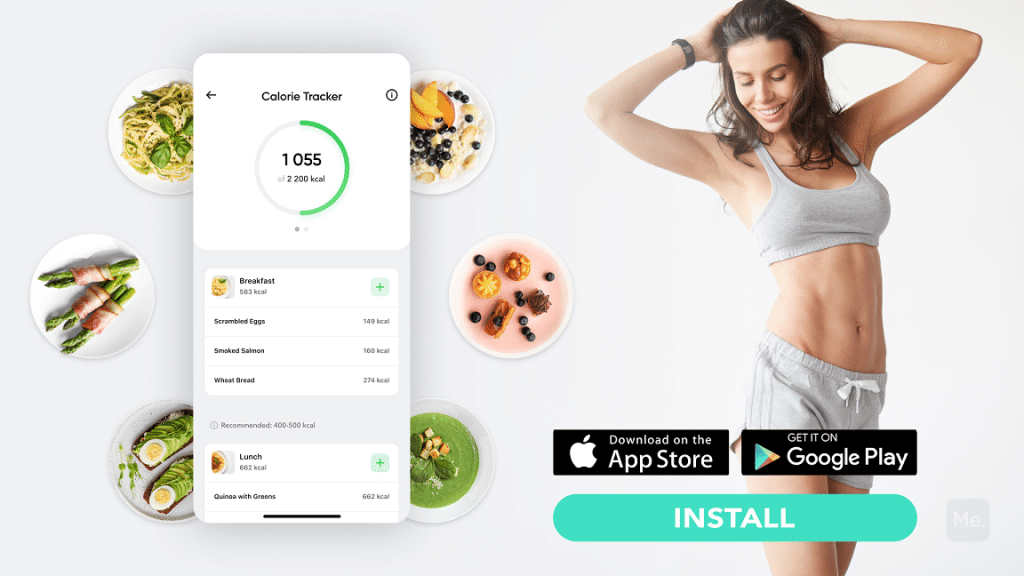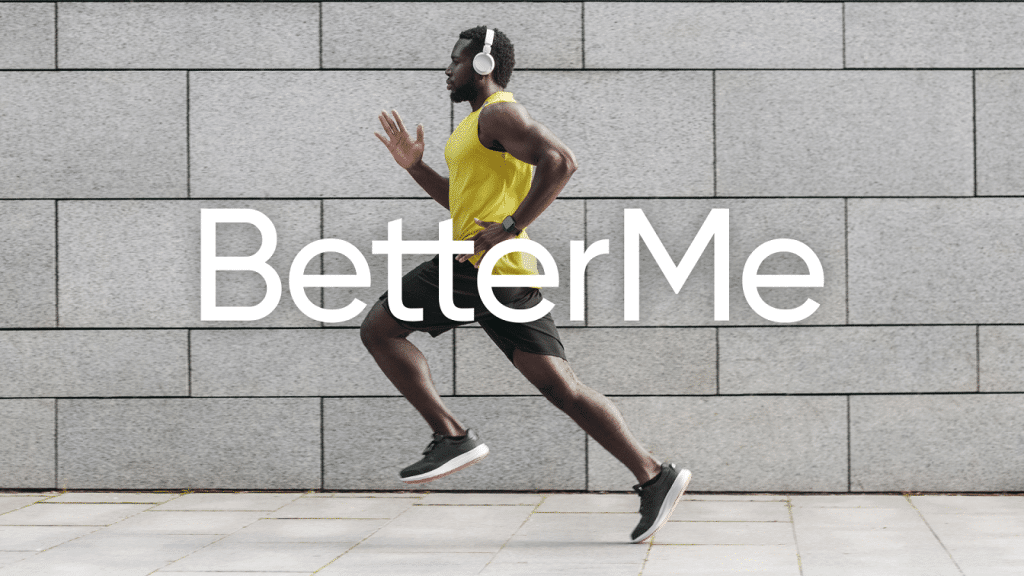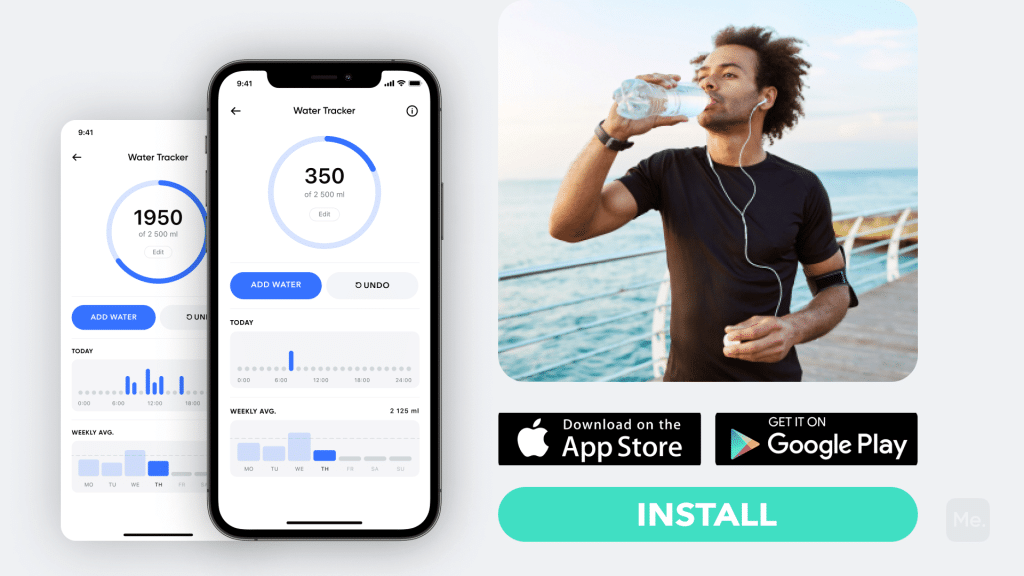The human body can perform seven fundamental movements—pull, push, hinge, squat, lunge, rotate and gait. Pushing motions in everyday life involve pushing objects away from us, such as opening a door or closing a drawer. In fitness and strength training, however, pushing motions are used to build muscles and increase explosive power. A popular example of a push exercise is the push press. The push press primarily works the shoulders. It’s a good exercise for building shoulder strength and mobility. The muscles of the chest, triceps and core must also work in order to perform the push press effectively. In this article, we’ll discuss the muscles used in the push press, the variations and benefits.
What Is The Push Press?
Many are familiar with the overhead press—a compound movement that mainly works the shoulders.
The push press is a variation of the overhead press, but instead of relying solely on upper body strength to lift the weight, it uses an explosive drive from the lower body to move heavier weights and create momentum (13).
Because the push press involves a similar motion to the jerk, you’ll be forgiven for confusing the two. The main difference between them is that the jerk requires a split stance with one foot in front of the other, whereas the push press does not.
Furthermore, while performing the push press, you only bend your knees once when you initiate the explosive movement; whereas in the jerk, you need to bend your knees twice (once when driving the weight up and again when receiving the weight).
What Muscles Are Worked For Push Press?
Just like other exercises, the push press targets primary muscles and also engages other muscles to help move the weight.
Primarily, the push press works the front deltoid muscles. These are the muscles located at the front of the shoulder and are responsible for pressing overhead movements (13).
Making your front deltoids stronger has several advantages, such as better posture and enhanced shoulder mobility (5). For those looking for defined, stronger, and bigger front deltoids, this will make your shoulders look more impressive
The push press also engages the:
- Lateral deltoids – these are the muscles located on the sides of the shoulder that help with abduction and upward rotation.
- Quads – while you drive with your legs, your quads help extend the hips and knees.
- Glutes – as you push with your legs, your glutes help stabilize the body and drive the movement.
- Triceps – during the push press, your triceps help stabilize the elbows and support the shoulders in overhead movements.
- Lower back – during the push press, your lower back helps keep you upright and maintain good posture.
- Adductors – your adductors are the muscles that pull your legs together and help keep you balanced while performing the push press.
- Core muscles – working as stabilizers, these muscles help brace your body and keep it in an upright position.
Read More: Wide Grip Bench Press – How To Do It & Its Benefits
What Are The Variations Of The Push Press?
There are several variations of the push press that you can incorporate into your strength training routine. Some variations include:
- Dumbbell push press – this variation involves using two dumbbells instead of a barbell. This is a great way to target the stabilizer muscles in your shoulders and arms. It’s especially useful if you have a weaker side and need to work on balancing strength.
- One-arm push press – this variation requires you to use only one arm at a time. It’s an excellent way to target one shoulder at a time and work on strength and stability.
- Kettlebell push press – this variation involves using two kettlebells and is ideal for those who want to build core stability. You may need to practice with a lighter weight at first, as the kettlebells can be a bit awkward to handle.
- One-arm kettlebell push press – as the name suggests, this variation involves using one kettlebell instead of two. It’s a great way to work on your unilateral strength and stability.
- Barbell push press – this variation involves using a barbell and is the most difficult of all the push press variations. It requires a larger range of motion and more control over the weight than its counterparts.
- Landmine push press – this variation is best suited for those looking to increase their overhead mobility and stability. You’ll need to use a landmine apparatus for this variation, which is a long bar that’s secured to the floor by one end.
How To Do The Push Press Properly
To perform the push press correctly, make sure to follow these steps:
- Start by standing with your feet shoulder-width apart and your toes slightly turned out.
- Hold the barbell at chest level, with your elbows pointing out to the sides.
- Keep your core engaged and your back straight.
- Bend your knees slightly. Drive your legs up, using the momentum from your legs to help press the barbell up overhead.
- At the top of the movement, keep your chest open and your arms extended.
- Return the barbell to chest level, pushing your hips back and bending your knees as you do so.
- Repeat for desired repetitions.
What Are The Benefits Of The Push Press?
The push press is a great full-body exercise that engages multiple muscle groups simultaneously. It has several benefits, including:
Increasing Flexibility And Range Of Motion
Shoulder mobility refers to how well your shoulder can move and extend its range of motion (11). Doing the push press regularly will help increase this flexibility, allowing you to better perform other exercises such as the overhead press.
Better shoulder mobility also translates to ease of movement in everyday life.
Your shoulders aren’t the only joint that benefits from increased mobility while doing the push press. Your wrists get a particularly good stretch, which is great for those who do a lot of typing or writing. It can also improve your grip strength, which is important for those who lift weights.
Want to build an attention-grabbing bubble butt, blast away fat that’s stored in all the wrong places, spring-clean your diet, turn back the clock on your skin, skyrocket your self-confidence and shatter your insecurities? Check out the BetterMe app and set this plan in motion!
Improved Full Body Strength And Power
The push press is a great way to build strength in all parts of your body.
Your legs and hip drive the initial movement, while your core and upper body balance and stabilize the weight. This helps improve overall strength and power, which is essential for activities such as sprinting or jumping (10).
It’s also a great exercise for athletes who need to quickly generate power and explosiveness. This makes the push press an important part of any sports training program.
Improved Posture
The push press is an excellent way to improve posture, as it requires you to keep your back straight while pressing the barbell overhead. This will help strengthen your core and back muscles, which support your spine.
Stronger core and back muscles will help keep your posture in check and reduce back pain (2) (7).
Calorie Burn
According to Harvard Health Publishing, a 185-pound person can burn at least 126 calories during a 30-minute weight-lifting session (1).
The push press is a great exercise for burning calories, as it requires both strength and power. This makes it an effective way to add intensity to your workouts and increase calorie burn.
The calorie burn from weight lifting doesn’t end when the workout is finished. By increasing your muscle mass, weight lifting also helps increase your resting metabolic rate (6) (9). This means you’ll be burning calories even when you’re not actively exercising.
How To Incorporate The Push Press Into Your Workout
The push press can be done as part of a larger workout. As a compound exercise, it works well with other exercises such as squats and overhead presses. Below are a few complementary exercises that you can use in combination with the push press:
- Squats – This full-body exercise engages your core, legs, and glutes.
- Overhead Press – This exercise focuses on the shoulders, triceps, and upper back.
- Bent Over Row – This exercise targets the upper back, lats, and biceps.
- Pull-ups – This exercise engages the lats, biceps, and forearms.
- Push-ups – This exercise targets the chest, triceps, and shoulders.
- Lateral raises – This exercise focuses on the shoulders and upper arms.
- Face pull – This exercise targets the rear deltoids and upper back.
By combining these exercises with the push press, you can create an effective full-body workout. Aim for 3-4 sets of 8-12 repetitions, with a minute or two of rest between sets. As you get stronger, you can gradually increase the weight for a more challenging workout.
You can also incorporate the push press into HIIT (High-Intensity Interval Training) workouts. Simply perform a few sets of push presses in between sprints or other cardiovascular exercises. This will help increase calorie burn and muscular endurance (8).
Read More: Sled Push Workout: How To Use It To Build Power, Speed, And Endurance
Tips For Beginners
If you’re new to the push press, here are a few tips for getting started:
Choosing The Right Weight
When choosing the weight for your push press, start light and gradually increase it over time. It’s better to focus on good form rather than trying to lift too much weight.
To determine your base weight, try to do 10-12 reps with good form. You can use this weight as your starting point and gradually increase it over time.
Warm Up
Before you start your push press, warm up with a few dynamic stretches that target the muscles you’ll be using. This will help get your body ready for the exercise and reduce the risk of injury (3).
In this case, you want to focus on stretching the shoulders, chest, and triceps. This will help loosen up your muscles and improve your range of motion.
Below are some ideal warm-up exercises for the push press and how to perform them:
- Arm Rotations – Stand with your feet shoulder-width apart and rotate your arms in circles 10 times in each direction.
- Lateral Arm Raises – Stand with your feet shoulder-width apart and raise your arms straight out to the sides 10 times.
- Arm Crosses – Stand with your feet shoulder-width apart and cross one arm over the other. With each crossing, slightly rotate your arms from side to side 10 times.
- Chest Openers – Stand with your feet shoulder-width apart and clasp your hands behind your back. Open your chest by pushing your arms outwards 10 times.
- Shoulder Rolls – Stand with your feet shoulder-width apart and roll your shoulders 10 times in each direction.
When it comes to weight loss, progress is made by inches, not miles, so it’s much harder to track and a lot easier to give up. BetterMe app is your personal trainer, nutritionist and support system all in one. Start using our app to stay on track and hold yourself accountable!
Lift With Good Form
Once you’re ready to begin your push press, make sure you maintain good form throughout the exercise.
Begin by standing tall with your feet shoulder-width apart, your arms extended in front of you, and your core engaged. As you lift the weight up, keep your back straight and your core tight to ensure proper form.
It’s also important to use a full range of motion when doing the push press. Instead of stopping the movement halfway, go through a full range of motion each time. This will ensure that all the muscles are engaged and help you get the most out of the exercise.
Use A Spotter
Having a spotter is always a good idea when doing any type of strength training. This will help make sure that you’re using proper form and can get help if needed.
Cool Down
Muscle soreness is common after performing the push press, so it’s important to cool down properly. Start by doing a few stretches that target the muscles you worked. This will help reduce soreness and improve recovery time (12).
You can then finish off your cool-down with a few minutes of light cardiovascular exercises. This will help flush lactic acid out and reduce post-workout fatigue (4).
Conclusion
The push press is an effective exercise for building strength and power in your shoulders, arms, and core. It works several muscles at once, which can help you quickly improve your overall strength and power. There are several variations of the push press that you can try in order to target different muscle groups and challenge yourself.
Get your personalized
meal plan!
DISCLAIMER:
This article is intended for general informational purposes only and does not serve to address individual circumstances. It is not a substitute for professional advice or help and should not be relied on for making any kind of decision-making. Any action taken as a direct or indirect result of the information in this article is entirely at your own risk and is your sole responsibility.
BetterMe, its content staff, and its medical advisors accept no responsibility for inaccuracies, errors, misstatements, inconsistencies, or omissions and specifically disclaim any liability, loss or risk, personal, professional or otherwise, which may be incurred as a consequence, directly or indirectly, of the use and/or application of any content.
You should always seek the advice of your physician or other qualified health provider with any questions you may have regarding a medical condition or your specific situation. Never disregard professional medical advice or delay seeking it because of BetterMe content. If you suspect or think you may have a medical emergency, call your doctor.
SOURCES:
- Calories burned in 30 minutes of leisure and routine activities (n.d., health.harvard.edu)
- Core strength training for patients with chronic low back pain (2015, ncbi.nlm.nih.gov)
- CURRENT CONCEPTS IN MUSCLE STRETCHING FOR EXERCISE AND REHABILITATION (2012, ncbi.nlm.nih.gov)
- Do We Need a Cool-Down After Exercise? A Narrative Review of the Psychophysiological Effects and the Effects on Performance, Injuries and the Long-Term Adaptive Response (2018, link.springer.com)
- Dynamite Delts: ACE Research Identifies Top Shoulder Exercises (2014, acefitness.org)
- Effect of resistance training on resting metabolic rate and its estimation by a dual-energy X-ray absorptiometry metabolic map (2014, nature.com)
- Effects of core strength training on core stability (2018, ncbi.nlm.nih.gov)
- Effects of high-intensity interval training combined with traditional strength or power training on functionality and physical fitness in healthy older men: A randomized controlled trial (2021, sciencedirect.com)
- Increasing muscle mass to improve metabolism (2013, ncbi.nlm.nih.gov)
- Power and impulse applied during push press exercise (2014, pubmed.ncbi.nlm.nih.gov)
- Shoulder – Physiopedia (n.d., physio-pedia.com)
- Stretching to prevent or reduce muscle soreness after exercise (2011, pubmed.ncbi.nlm.nih.gov)
- Weightlifting Overhead Pressing Derivatives: A Review of the Literature (2019, link.springer.com)
